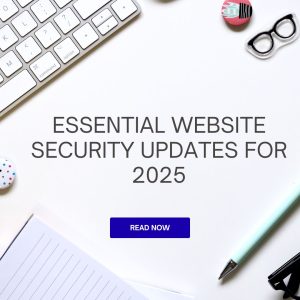Your website is more than an online presence—it’s the digital front door to your business. If it’s not secure, you’re leaving that door unlocked for cybercriminals, malware, and data breaches. In 2025, with online threats growing more sophisticated, keeping your website updated is one of the most important steps you can take to protect your clients and your brand.
Here are the essential website security updates every business owner should know—and why they matter.
1. Keep Your CMS, Plugins, and Themes Updated
Whether your website runs on WordPress, Shopify, or another platform, outdated software is the number one cause of vulnerabilities.
-
Update your CMS (Content Management System) as soon as new versions are released.
-
Apply updates to plugins and themes, since these are common hacker entry points.
-
Remove unused plugins and themes to reduce risks.
https://owasp.org/
👉 Think of updates as digital locks—every patch closes a door hackers are trying to open.

2. Use an SSL Certificate (and Keep It Active)
An SSL certificate (HTTPS in your browser bar) protects data exchanged between your website and visitors. It’s not optional anymore—it’s essential for:
-
Protecting sensitive customer information.
-
Boosting your Google search ranking.
-
Building trust with visitors who expect to see a secure padlock icon.
3. Enable Two-Factor Authentication (2FA)
Strong passwords aren’t enough anymore. Adding two-factor authentication for admin logins ensures that even if credentials are stolen, attackers can’t access your site.
4. Schedule Regular Backups
Even the most secure websites can face unexpected issues. Regular, automated backups mean you can restore your website quickly without losing business or client data.
5. Monitor for Malware and Suspicious Activity
Hackers don’t always announce their presence—they often inject malware quietly.
-
Install a security plugin or service that scans daily.
-
Set up alerts for suspicious login attempts or unauthorized changes.
6. Keep User Access Under Control
Not every employee or contractor needs full admin access.
-
Assign roles with the principle of “least privilege.”
-
Remove old user accounts immediately when staff leave or projects end.
7. Stay Ahead with a Security Maintenance Plan
Security isn’t a one-time task—it’s ongoing. A professional maintenance plan ensures:
-
Updates are applied regularly.
-
Vulnerabilities are patched quickly.
-
You always know your website is protected.
Bottom Line
A secure website isn’t only about protecting data—it’s about protecting your reputation, your clients, and your revenue. By keeping up with these essential security updates, you’re not only avoiding costly breaches but also building trust with everyone who visits your website.
✅ Pro Tip: Review your website’s security quarterly. Make updates part of your business routine so your site remains safe year-round.
